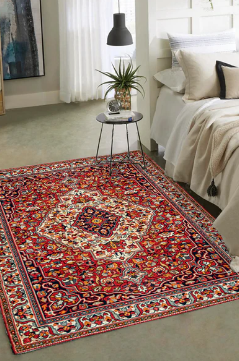Persian rugs, with their rich colors, intricate designs, and timeless beauty, are not merely floor coverings but artifacts that carry profound cultural value. These masterpieces of weaving artistry are deeply rooted in the history and culture of Iran. In this article, we explore the cultural significance and historical value of Persian rugs, shedding light on their enduring legacy as cultural artifacts.
Preserving Cultural Heritage: Persian rugs are more than just decorative items; they represent a tangible link to the cultural heritage of Iran. For centuries, Persian rug weaving has been a significant aspect of Iranian culture, with each rug serving as a testament to the craftsmanship, traditions, and stories of the weavers. These rugs have witnessed the passage of time, preserving the essence of the past and offering a glimpse into the rich tapestry of Iranian history.
Symbolism and Design: The intricate designs found in Persian rugs are imbued with symbolism and cultural meaning. Each rug tells a story, reflects the customs and beliefs of a particular region, or signifies important cultural events. From delicate floral motifs symbolizing rebirth and growth to geometric patterns representing unity and harmony, the designs are a visual representation of Iranian culture and aesthetics.
Techniques Passed Down Through Generations: The art of Persian rug weaving has been passed down through generations, with each weaver adding their unique touch while staying true to traditional techniques. The weaving process involves hand-knotting individual threads, a labor-intensive and time-consuming method that requires exceptional skill and patience. This transmission of knowledge and skills from one generation to the next is a testament to the strong cultural heritage and commitment to preserving traditional craftsmanship.

Distinctive Regional Styles: Persian Rugs are known for their distinctive regional styles, each reflecting the influences of its specific geographic location. From the bold and vibrant colors of the tribal rugs of Bakhtiari to the intricate floral motifs of the rugs from Isfahan, each region has its characteristic design elements and weaving techniques. These regional styles not only showcase the diversity of Iranian culture but also contribute to the cultural value of Persian rugs.
Collectible Art Pieces: Beyond their functional use, Persian rugs have gained recognition as valuable collectible art pieces. Art enthusiasts, interior designers, and collectors appreciate their historical significance, artistic merit, and enduring beauty. Persian rugs have found their place in prestigious art collections and museums worldwide, further elevating their cultural value and solidifying their status as art forms.
Preservation and Conservation: The preservation and conservation of Persian rugs are of paramount importance to safeguard their cultural value for future generations. Organizations and experts work tirelessly to promote sustainable practices, raise awareness about the significance of Persian rugs, and support local weavers. By fostering appreciation, understanding, and responsible consumption, we contribute to the long-term preservation of these cultural treasures.
Global Appreciation: The allure of Persian rugs extends far beyond the borders of Iran, captivating individuals around the world with their intricate craftsmanship and historical significance. Their presence in homes, galleries, and exhibitions serves as a bridge between cultures, fostering cross-cultural understanding and appreciation for Iranian artistry. The global recognition and appreciation of Persian rugs strengthen their cultural value and promote cultural exchange.
Conclusion: Persian rugs stand as timeless artifacts, weaving together history, culture, and artistry. Their cultural value goes beyond their aesthetic appeal, representing the traditions, stories, and skills of the Iranian people. As we recognize and celebrate the cultural value of Persian rugs, we contribute to the preservation of an ancient craft and the appreciation of the rich heritage they represent. These masterpieces of weaving continue to inspire awe and admiration, transcending time and borders as testaments to the enduring cultural legacy of Iran.
